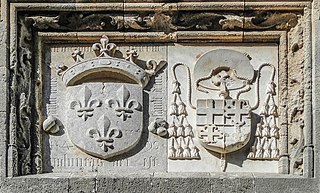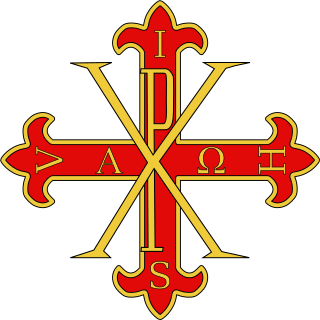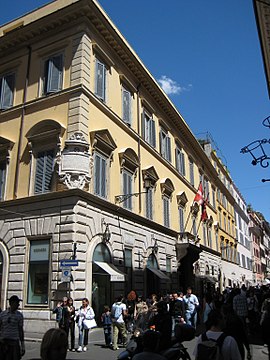
The Sovereign Military Order of Malta (SMOM), officially the Sovereign Military Hospitaller Order of Saint John of Jerusalem, of Rhodes and of Malta, commonly known as the Order of Malta or Knights of Malta, is a Catholic lay religious order, traditionally of a military, chivalric, and noble nature. Though it possesses no territory, the order is often considered a sovereign entity under international law.

The properties of the Holy See are regulated by the 1929 Lateran Treaty signed with the Kingdom of Italy. Although part of Italian territory, some of them enjoy extraterritoriality similar to those of foreign embassies.

The Equestrian Order of the Holy Sepulchre of Jerusalem, also called Order of the Holy Sepulchre or Knights of the Holy Sepulchre, is a Catholic order of knighthood under the protection of the Holy See. The pope is the sovereign of the order. The order creates canons as well as knights, with the primary mission to "support the Christian presence in the Holy Land". It is an internationally recognized order of chivalry.

The European microstates or European ministates are a set of very small sovereign states in Europe. In modern contexts the term is typically used to refer to the six smallest states in Europe by area: Andorra, Liechtenstein, Malta, Monaco, San Marino, and Vatican City. Four of these states are monarchies, three principalities—Andorra, Liechtenstein, and Monaco—and one papacy, Vatican City. These states trace their status back to the first millennium or the early second millennium except for Liechtenstein, created in the 17th century.

Campo Marzio is the 4th rione of Rome, identified by the initials R. IV. It belongs to the Municipio I and covers a smaller section of the area of the ancient Campus Martius. The logo of this rione is a silver crescent on a blue background.

The Order of Pope Pius IX, also referred as the Pian Order, is a papal order of knighthood originally founded by Pope Pius IV in 1560. Currently, it is the highest honor conferred by the Holy See .The awarding of the order fell into disuse and was re-instituted by Pope Pius IX as a continuation on 17 June 1847.

A langue or tongue was an administrative division of the Knights Hospitaller between 1319 and 1798. The term referred to a rough ethno-linguistic division of the geographical distribution of the Order's members and possessions. Each langue was subdivided into Priories or Grand Priories, Bailiwicks and Commanderies. Each langue had an auberge as its headquarters, some of which still survive in Rhodes, Birgu and Valletta.

Fra' Angelo de Mojana di Cologna was an Italian nobleman and Prince and Grand Master of the Sovereign Military Order of Malta from 1962 to 1988.

The Order of Knights of the Hospital of Saint John of Jerusalem, commonly known as the Knights Hospitaller, was a medieval and early modern Catholic military order. It was founded in the Kingdom of Jerusalem in the 12th century and had headquarters there until 1291, thereafter being based in Kolossi Castle in Cyprus (1302–1310), the island of Rhodes (1310–1522), Malta (1530–1798), and Saint Petersburg (1799–1801).

The Sacred Military Constantinian Order of Saint George (SMOCG) (Italian: Sacro Militare Ordine Costantiniano di San Giorgio, Spanish: Sagrada Orden Militar Constantiniana de San Jorge), also historically referred to as the Imperial Constantinian Order of Saint George and the Order of the Constantinian Angelic Knights of Saint George, is a dynastic order of knighthood of the House of Bourbon-Two Sicilies. Currently, the grand magistry of the order is disputed among the two claimants to the headship of the former reigning House of Bourbon-Two Sicilies as heirs of the House of Farnese, namely Prince Pedro and Prince Carlo. The order was one of the rare orders confirmed as a religious-military order in the papal bull Militantis Ecclesiae in 1718 owing to a notable success in liberating Christians in the Peloponnese. Together with the Sovereign Military Order of Malta and the Order of Saints Maurice and Lazarus (confirmed by papal bull in 1572) it is one of the three international Catholic Orders that still has this status today. Although it is not an order of chivalry under patronage of the Holy See, membership is restricted to practising Catholics.

The Sovereign Military Order of Malta (SMOM) is a sovereign entity maintaining diplomatic relations with 112 sovereign states. Additionally, it has observer status or representation at multiple intergovernmental organisations. The Order has non-diplomatic official relations with five more states: France, Belgium, Switzerland, Luxembourg and Canada. The Order exchanges ambassadors with the European Union and the State of Palestine.

Villa del Priorato di Malta or Magistral Villa, located on the Aventine Hill in Rome, is one of the two institutional seats of the government of the Sovereign Military Order of Malta. Along with Magistral Palace, the estate is granted extraterritorial status by Italy. It also hosts the Grand Priory of Rome and the embassy of the Sovereign Order of Malta to Italy.

This is an article about the postage stamps and postal history of the Sovereign Military Order of Malta.

The Sovereign Military Order of Malta passport is a travel document issued to officials and diplomats of the Sovereign Military Order of Malta (SMOM). The order issues biometric passports which are fully ICAO9303 compliant.

Fra' Alessandro Ponziano Borgia was the leader of the Sovereign Military Order of Malta as Lieutenant of the Grand Master from 1865 to 1872.

The Auberge de Bavière is a palace in Valletta, Malta. It was built as Palazzo Carneiro in 1696, and it was the residence of Grand Master Marc'Antonio Zondadari in the early 18th century. In 1784, it was converted into the auberge for the Anglo-Bavarian langue of the Order of Saint John, and it remained so until the French occupation of Malta in 1798.

Palazzo Correa, also known as Casa Correa, Correa de Sousa Palace or Palazzo Hompesch, was a 17th-century palace in Valletta, Malta, located in Old Bakery Street. It was built on the designs to architect Carlo Gimach in the Mannerist style, the first in Valletta and very unusual to the period.
Carlo Gimach was a Maltese architect, engineer and poet who was active in the late 17th and early 18th centuries. Throughout his career, he worked in Malta, Portugal and Rome, and he is mostly known for designing Palazzo Carneiro in Valletta, renovating the Monastery of Arouca in Portugal, and restoring the Basilica of St. Anastasia in Rome. He is known to have written a number of poems and other literary works, but these are all lost with the exception of one cantata which he wrote in 1714.


















